清华大学介绍中英文互译介绍讲课资料
- 格式:ppt
- 大小:5.80 MB
- 文档页数:41
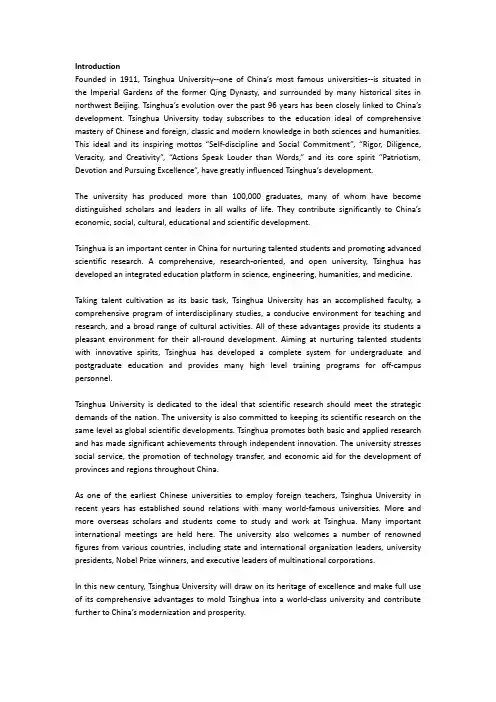
IntroductionFounded in 1911, Tsinghua University--one of China’s most famous universities--is situated in the Imperial Gardens of the former Qing Dynasty, and surrounded by many historical sites in northwest Beijing. Tsinghua’s evolution over the past 96 years has been closely linked to China’s development. Tsinghua University today subscribes to the education ideal of comprehensive mastery of Chinese and foreign, classic and modern knowledge in both sciences and humanities. This ideal and its inspiring m ottos “Self-discipline and Social Commitment”, “Rigor, Diligence, Veracity, and Creativity”, “Actions Speak Louder t han Words,” and its core spirit “Patriotism, Devotion and Pursuing Excellence”, have greatly influenced Tsinghua’s development.The university has produced more than 100,000 graduates, many of whom have become distinguished scholars and leaders in all walks of life. They contribute significantly to China’s economic, social, cultural, educational and scientific development.Tsinghua is an important center in China for nurturing talented students and promoting advanced scientific research. A comprehensive, research-oriented, and open university, Tsinghua has developed an integrated education platform in science, engineering, humanities, and medicine.Taking talent cultivation as its basic task, Tsinghua University has an accomplished faculty, a comprehensive program of interdisciplinary studies, a conducive environment for teaching and research, and a broad range of cultural activities. All of these advantages provide its students a pleasant environment for their all-round development. Aiming at nurturing talented students with innovative spirits, Tsinghua has developed a complete system for undergraduate and postgraduate education and provides many high level training programs for off-campus personnel.Tsinghua University is dedicated to the ideal that scientific research should meet the strategic demands of the nation. The university is also committed to keeping its scientific research on the same level as global scientific developments. Tsinghua promotes both basic and applied research and has made significant achievements through independent innovation. The university stresses social service, the promotion of technology transfer, and economic aid for the development of provinces and regions throughout China.As one of the earliest Chinese universities to employ foreign teachers, Tsinghua University in recent years has established sound relations with many world-famous universities. More and more overseas scholars and students come to study and work at Tsinghua. Many important international meetings are held here. The university also welcomes a number of renowned figures from various countries, including state and international organization leaders, university presidents, Nobel Prize winners, and executive leaders of multinational corporations.In this new century, Tsinghua University will draw on its heritage of excellence and make full use of its comprehensive advantages to mold Tsinghua into a world-class university and contribute further to China’s modernization and prosperity.HistoryTsinghua University was instituted in 1911 as Tsinghua Xuetang, a government sponsored preparatory school for training students who were selected to study in the United States. The name National Tsinghua University was adopted in 1928.The Resistance War against the Japanese Invasion in 1937 shattered the serenity of the campus and forced Tsinghua to move to Kunming. There, with Peking University and Nankai University, it formed the Southwest Associated University. In 1946, Tsinghua moved back to its original Peking location. At that time, the University had 26 departments under five faculties that included arts, law, science, engineering, and agricultural science.As part of the nationwide higher education restructuring in 1952, Tsinghua University was molded into a polytechnic institution focused on engineering. It became known as China’s “cradle of engineers” due to the success of its faculty and students. Tsinghua University has flourished since 1978 with the resumption of departments in science, economics, humanities and social sciences, and law. In 1999, the former Central Academy of Arts and Design of China joined Tsinghua University.In 1993, Tsinghua established its goal to build itself into a world-class university. With the support of the national 211 Project and 985 Program, Tsinghua has taken new steps in discipline development, talent cultivation, faculty development, scientific research, and international cooperation.Schools and DepartmentsTsinghua University has established School of Architecture, School of Civil Engineering, School of Mechanical Engineering, School of Aerospace, School of Information Science and Technology, Department of Environmental Science and Engineering, Department of Electrical Engineering, Department of Engineering Physics, Department of Chemical Engineering, Department of Materials Science and Engineering, School of Sciences, School of Humanities and Social Sciences, School of Economics and Management, School of Public Policy and Management, School of Law, Academy of Arts and Design, School of Medicine, School of Journalism and Communication, Institute of Nuclear and New Energy Technology, Teaching and Research Division of Physical Education, Graduate School at Shenzhen and School of Continuing Education.EducationTsinghua is very proud of its excellent students. Education is always the top priority. Taking quality as its core value, the university attaches great importance to improving the teaching of fundamental courses and training in practical skills. Tsinghua has formed a high level research oriented educational system to meet China’s sustainable development requirements.Undergraduate EducationThe Tsinghua University undergraduate program offers a general professional education with a broad scope. Instruction is research-oriented. Students are encouraged to make research an integral part of their studies. Aiming at improving students’consciousness of innovation and creativity, Tsinghua teaches students in accordance with their aptitude. The university adoptsvarious models to foster an innovative spirit among its students. Currently Tsinghua offers over 60 undergraduate programs and has currently more than 13,000 undergraduate students.Graduate EducationBased on high level research activities, Tsinghua University graduate education seeks to develop the students’ capacity for creat ive and innovative thinking. At present, the university has developed a comprehensive system to provide graduate academic degree programs. There are also professional degree programs to meet society’s needs. Tsinghua currently enrolls nearly 18,000 graduate students. There are among these more than 5,000 students working towards doctoral degrees, nearly 6,000 towards academic masters degrees, and more than 7,000 towards professional masters degrees.Foreign StudentsTsinghua University attracts excellent students from around the world. In recent years, the number of foreign students pursuing academic degrees has increased substantially. At present, about 3,000 students from nearly 100 countries study at Tsinghua.ResearchTsinghua has a number of high-level scientific platforms, including the Tsinghua National Lab for Information Science and Technology, a number of national key disciplines, state key laboratories, and cross-department research institutes. Committed to the ideal that scientific research should meet the strategic demands of the nation, the university makes efforts to keep up with the advanced world standards. Tsinghua University puts equal emphasis on basic and applied research. It encourages the development of interdisciplinary study and has improved significantly researchers’ capacities for scientific innovation. Tsin ghua has made significant progress in basic research, applied research, technology transfer, and studies in the humanities and social sciences.FacultyTsinghua is home to a galaxy of famous professors. The university believes in the principle that the quality of a university depends on the quality of its faculty. Tsinghua adopted a “talent strategy” and has hired and cultivated a great number of accomplished scholars, renowned teachers, and scientists. At present Tsinghua has more than 2,800 teachers. The university currently has the highest number of academicians and nationally renowned teachers of any college or university in China.International Exchange and CooperationTsinghua University actively promotes international cooperation and exchanges. It has signed agreements with many prestigious universities throughout the world. The cooperation includes mutual visits, collaborative scientific research, joint education programs, and extensive exchange programs. Each year, many overseas scholars, state and international organization leaders, and CEOs of international companies visit Tsinghua. The University also maintains several high level research collaborations with world-renowned universities and corporations. The number of teachers and students going abroad has also increased. As Tsinghua becomes more international in its culture and structure, more and more foreign students come to study here at theundergraduate and graduate levels.。
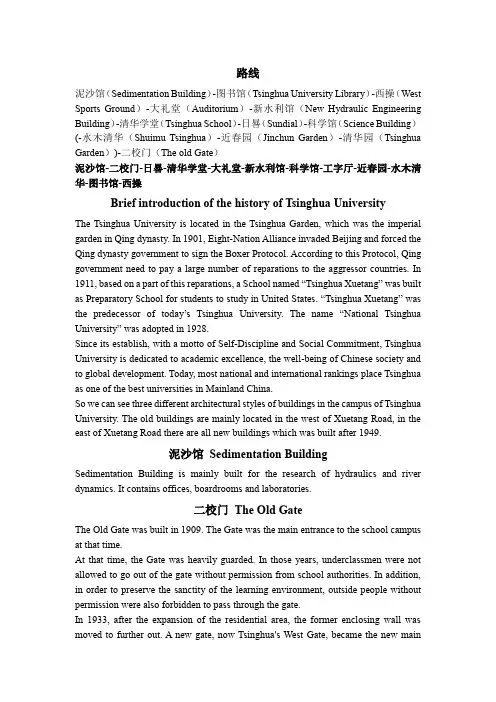
路线泥沙馆(Sedimentation Building)-图书馆(Tsinghua University Library)-西操(West Sports Ground)-大礼堂(Auditorium)-新水利馆(New Hydraulic Engineering Building)-清华学堂(Tsinghua School)-日晷(Sundial)-科学馆(Science Building)(-水木清华(Shuimu Tsinghua)-近春园(Jinchun Garden)-清华园(Tsinghua Garden))-二校门(The old Gate)泥沙馆-二校门-日晷-清华学堂-大礼堂-新水利馆-科学馆-工字厅-近春园-水木清华-图书馆-西操Brief introduction of the history of Tsinghua UniversityThe Tsinghua University is located in the Tsinghua Garden, which was the imperial garden in Qing dynasty. In 1901, Eight-Nation Alliance invaded Beijing and forced the Qing dynasty government to sign the Boxer Protocol. According to this Protocol, Qing government need to pay a large number of reparations to the aggressor countries. In 1911, based on a part of this reparations, a School named “Tsinghua Xuetang” was built as Preparatory School for students to study in United States. “Tsinghua Xuetang” was the predecessor of today’s Tsinghua University. The name “National Tsinghua University” was adopted in 1928.Since its establish, with a motto of Self-Discipline and Social Commitment, Tsinghua University is dedicated to academic excellence, the well-being of Chinese society and to global development. Today, most national and international rankings place Tsinghua as one of the best universities in Mainland China.So we can see three different architectural styles of buildings in the campus of Tsinghua University. The old buildings are mainly located in the west of Xuetang Road, in the east of Xuetang Road there are all new buildings which was built after 1949.泥沙馆Sedimentation BuildingSedimentation Building is mainly built for the research of hydraulics and river dynamics. It contains offices, boardrooms and laboratories.二校门The Old GateThe Old Gate was built in 1909. The Gate was the main entrance to the school campus at that time.At that time, the Gate was heavily guarded. In those years, underclassmen were not allowed to go out of the gate without permission from school authorities. In addition, in order to preserve the sanctity of the learning environment, outside people without permission were also forbidden to pass through the gate.In 1933, after the expansion of the residential area, the former enclosing wall was moved to further out. A new gate, now Tsinghua's West Gate, became the new mainentrance. Ever since, the original gate has been called Er Xiao Men (means "the second school gate").The Old Gate was demolished in 1960's. Donated by Tsinghua University Alumni, it was rebuilt in 1991, following the original design.日晷SundialThe sundial is a classical timer used in ancient times. It is a gift given by the graduates in 1920. It serves as a reference for class time for students, and also a reminder to them that every second of time should be valued.It was carved with the motto "Actions speak louder than words" in both Chinese and Latin characters together with the date of construction. Today, the motto "Actions speak louder than words" has already become the school spirit of Tsinghua University. The?Sundial?is?made?of?silver?covered?with?enamel.?The Sundial stood in front of Tsinghua’s grassy quadrangle before the foundation of People’s Republic of China (about 1948). The planar surface of the sundial turned to be stony then, since the former silver one covered with enamel disappeared. Tsinghua often had struggle meeting on the grassy quadrangle during the Cultural Revolution. The oval grassy quadrangle was changed into a rectangle and the Sundial was removed in order to enlarge the field. The place where the Sundial used to stand was stuffed with cement, and the Sundial was missing. After the Cultural Revolution, Tsinghua began to collect the old things of the university, and the Sundial was found in a pile of stones, but its planar disappeared. The Sundial we see nowadays had been repaired after that, and its planar was newly made. It was here since the 70th anniversary of the foundation of Tsinghua.清华学堂Tsinghua XuetangTsinghua Xuetang is one of the landmarks of Tsinghua University. Xuetang means school, a place for teaching. The construction of Tsinghua Xuetang was completed in 1916. It was one of the main buildings of the school at its early stage.The four Chinese characters painted above the main entrance read "Tsinghua School", the first name of the institution when it was founded. The inscription was by Na Tong, a Great Scholar and Grand Minister in late Qing Dynasty.Tsinghua Xuetang served as classrooms for senior students at the beginning of the school. After the east part was built, it remained a dormitory for senior graduating students for several years. In 1925, the Institute of Chinese Classics was set up here. The renowned “Four Tutors" in the Institute of Chinese Classics: Liang Qichao, WangGuowei, Zhao Yuanren, Chen Yinque, (梁启超、王国维、赵元任、陈寅恪)the famous archeologist Li Ji, and litterateur Wu Mi were brought together.In the last few decades, it was used as teaching building and classrooms. Now it is the offices of some main administration departments: the Graduate School, the undergraduate academic department and the R&D department.大礼堂AuditoriumThe Auditorium is a symbol of Tsinghua University. The Auditorium was designed by American architect . Murphy in 1913, and completed in 1917. It is one of the four major building projects carried out by Tsinghua School, together with Tsinghua Xuetang, the old library, and the west gymnasium. Since the American designer didn’t believe the quality of building materials in China, they imported the costing cork floors, chairs and even the red bricks all from America. The design of Auditorium based on the image of the auditorium in University of Pennsylvania. Endowed with the feature of both Greek and Roman building, looks very elegant.For a long time, the building has been long viewed as the symbol of persistence, simplicity and indomitable will. Though more than 90 years has passed, the Auditorium still maintains quite well. Large-scaled activities like every Student Festival of different departments and some concerts are often held here.新水利馆Department of Hydraulic EngineeringThe Water Conservancy Building is hosts the Department of Hydraulic Engineering. Constructed in the year 1955. Its designer is Mr. Zhou Weiquan. In order to match the style of the buildings around the great auditorium, the designer applied the same methods in his general drawing arrangement and architectural style arrangement. The appearance of the building consists of elements like red brick wall and arch door, window and gate.Department of Hydraulic Engineering dates back to the Hydraulic Engineering group and Hydraulic Engineering laboratory of the Civil Engineering Department in the late the school-department adjustment in 1952, department of Hydraulic and department of Hydropower Engineering were founded. In 1955, it moved into the new department building and was reestablished as Department of Hydraulic Engineering.The department has a strong teaching staff, including six academicians and 40 professors. The former President of China, Hu Jintao graduated from this departmentin 1965.智者乐水、仁者乐山The statue of “Zhi Zhe Le Shui, Ren Zhe Le Shan” was built in 2002 to commemorate the 50th anniversary of the Department of Hydraulic Engineering. The statue was donated by alumni graduated in 1965, including our former President Hu Jintao and former Minister of Water Resources Wang Shucheng.The sentence is from Confucian Analects. The left part of the statue represents hard mountain rocks, and the right part represents flowing water. It means wise men are sharp-minded, just like flowing waters, kind men are kindhearted and tolerant, just like staunch mountains. That is how the statue comes into being.科学馆Science BuildingThe Science Building is also one of the Four Early Architectures of Tsinghua University. It was first built in 1917 and was finished 1919. Again Mr. . Murphy added his expertise and talents to the design of the Science Building.There are characters in both Chinese and old English of “SCIENCE BVILDING” on the lintel of the door which are distinguished and simple. It was used for science teaching and experiments when first built because it possesses of the most advanced equipment. Later it served as Physics Department Building for 73 years till the newly-built Physics Department teaching building came into use. This building brought out countless scientists and many of them are famous all around the world for their contribution to our earth, such as Wang Ganchang, Wang Zhuxi, Peng Hengwu, Qian Sanqiang, He Zehui and Lin Jiaqiao. (王淦昌、王竹溪、彭恒武、钱三强、何泽慧、林家翘)Among the 23 scientists honored by the country in 1999 for their great contributions to the astonishing accomplishment of the “Atomic Bomb, hydrogen Bomb and artificial satellite”, 9 graduated from Physics Department of Tsinghua University.Now, the Science Building is the dreaming place for the young generation nationwide who is interested in science.清华园Tsinghua GardenThe more popular name of the garden is Gong Zi Ting -- which in Chinese means H-Shaped House. Viewed from above, the central part of the house resembles the letter "H", with its two halls in the front and back connected by a short corridor in the middle.? The garden was the residence of a Qing emperor's brother's family. In the early days of Tsinghua School, the garden was used as the school's first head office building. Student enrollment lists were posted on the wall at the front gate. For some years in its history,the east room in the front section was used as the Music Center, the west room as the teacher's reading room and the back section to accommodate distinguished foreign guests. The great Indian poet Tagore stayed there when he visited China in 1924.近春园(荷塘月色)Jinchun GardenJinchun Garden was the residence of emperor Xian Feng before he succeeded his father. After he took power, he changed the name “Xichun garden” into “Tsinghua garden” and extended the whole garden.In the summer of 1927, during one sleepless night, the well-known Professor Zhu Ziqing of Tsinghua, went for a stroll around the lake area to think about the tremendous changes occurring in Chinese society. When the lovely landscape caught his attention, he was moved to write the now-classic essay "The View of the Lotus Pond in the Moonlight."水木清华Shuimu TsinghuaShuimu Tsinghua which means "clear water and trees surrounding Tsinghua" is one of the most captivating spots in Tsinghua. It was founded in the 18th century. It used to be a part of the imperial garden, so it is also called 'garden within a garden'.The four Chinese characters "Shui Mu Tsing Hua" painted on the top of the main gate, were copied from an inscription by Emperor Kang Xi. On the opposite of the main gate, there exists a sculpture of famous proser Mr. Zhu Ziqing.清华图书馆Tsinghua University LibraryThe Tsinghua Library is one of the landmarks at Tsinghua University which now has a collection of more than 4 million books. Tsinghua Library consists of three parts: the old library, Yifu library and Li Wenzheng Library which is also called the north library. The old library also consists of the early part and the latter extension part. The Tsinghua Library has been under construction four times and its life span covers more than 90 years.The early part of the old library was designed by a famous American architect . Murphy and was completed in 1919. It was considered to be one of the Four Tsinghua Early Buildings. The extension part of the old library was finished in 1931 and covered an area of three times as large as the early part. The Yifu library was built in 1991. It was donated by the famous philanthropist Mr. Shao Yifu and designed by academician Mr. Guan Zhaoye from the School of Architecture. Mr. Guan used what most Tsinghua old architectures adopted such as the red bricks and grey tiles in order to keep consistency with the style of the previous one. The Li Wenzheng library was completed in this year.It was donated by the industrialist Mr. Li wenzheng and also designed by architect Mr. Guan Zhaoye.The library is so superior in design that it received many honors, including “one of the Top 10 architectures of Beijing” in the Library has deep cultural and human atmosphere. Mr. Qian Zhongshu had once made up his mind to read all the books from the library and Mr. Cao Yu wrote his most famous drama Thunderstorm (Lei Yu) in the library.西操场West Sports GroundWest Sports Ground is famous for its blue athletic track which was repainted last year. Its original color is red. In the west of the playground is west Gymnasium.It was designed by architect . Murphy and was completed in 1919. It was considered to be one of the Four Tsinghua Early Buildings. When it was founded, the gym was one of the most advanced of its kind in the country. It housed a basketball court, an athletic track, and various kinds of athletic equipment. It also has an indoor swimming pool.It has been a gathering place for the most outstanding people in the field of physical education, bringing up thousands of talented athletes to represent China. After the liberation of China, former Chairman Mao Zedong used to swim there. Pioneers of physical education such as John Ma and Hao Gengshen taught there for decades.。
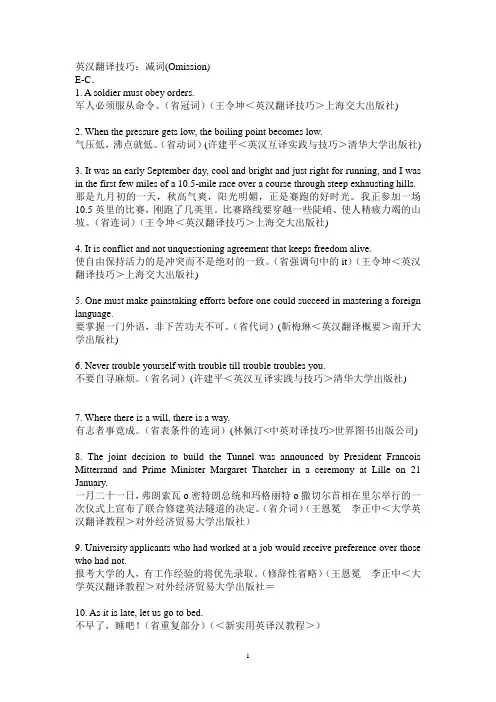
英汉翻译技巧:减词(Omission)E-C.1. A soldier must obey orders.军人必须服从命令。
(省冠词)(王令坤<英汉翻译技巧>上海交大出版社)2. When the pressure gets low, the boiling point becomes low.气压低,沸点就低。
(省动词)(许建平<英汉互译实践与技巧>清华大学出版社) 3. It was an early September day, cool and bright and just right for running, and I was in the first few miles of a 10.5-mile race over a course through steep exhausting hills.那是九月初的一天,秋高气爽,阳光明媚,正是赛跑的好时光。
我正参加一场10.5英里的比赛,刚跑了几英里。
比赛路线要穿越一些陡峭、使人精疲力竭的山坡。
(省连词)(王令坤<英汉翻译技巧>上海交大出版社)4. It is conflict and not unquestioning agreement that keeps freedom alive.使自由保持活力的是冲突而不是绝对的一致。
(省强调句中的it)(王令坤<英汉翻译技巧>上海交大出版社)5. One must make painstaking efforts before one could succeed in mastering a foreign language.要掌握一门外语,非下苦功夫不可。
(省代词)(靳梅琳<英汉翻译概要>南开大学出版社)6. Never trouble yourself with trouble till trouble troubles you.不要自寻麻烦。
(省名词)(许建平<英汉互译实践与技巧>清华大学出版社) 7. Where there is a will, there is a way.有志者事竟成。
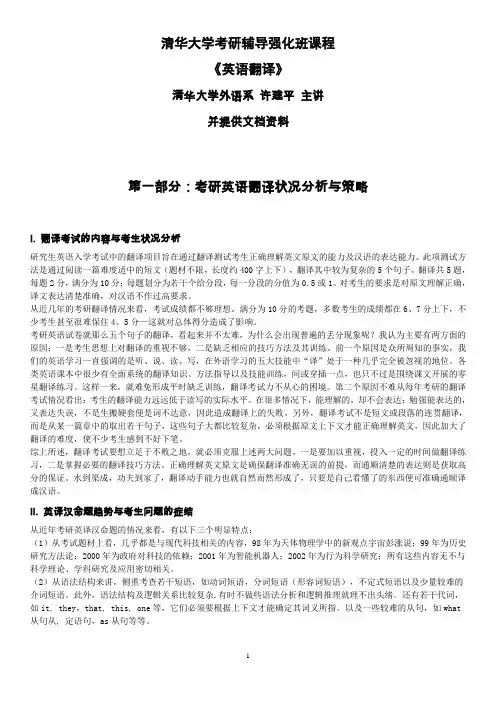
清华大学考研辅导强化班课程《英语翻译》清华大学外语系许建平主讲并提供文档资料第一部分:考研英语翻译状况分析与策略I. 翻译考试的内容与考生状况分析研究生英语入学考试中的翻译项目旨在通过翻译测试考生正确理解英文原文的能力及汉语的表达能力。
此项测试方法是通过阅读一篇难度适中的短文(题材不限,长度约400字上下),翻译其中较为复杂的5个句子。
翻译共5题,每题2分,满分为10分;每题划分为若干个给分段,每一分段的分值为0.5或1。
对考生的要求是对原文理解正确,译文表达清楚准确,对汉语不作过高要求。
从近几年的考研翻译情况来看,考试成绩都不够理想。
满分为10分的考题,多数考生的成绩都在6、7分上下,不少考生甚至很难保住4、5分—这就对总体得分造成了影响。
考研英语试卷就那么五个句子的翻译,看起来并不太难,为什么会出现普遍的丢分现象呢?我认为主要有两方面的原因:一是考生思想上对翻译的重视不够,二是缺乏相应的技巧方法及其训练。
前一个原因是众所周知的事实,我们的英语学习一直强调的是听、说、读、写,在外语学习的五大技能中“译”处于一种几乎完全被忽视的地位。
各类英语课本中很少有全面系统的翻译知识、方法指导以及技能训练,间或穿插一点,也只不过是围绕课文开展的零星翻译练习。
这样一来,就难免形成平时缺乏训练,翻译考试力不从心的困境。
第二个原因不难从每年考研的翻译考试情况看出:考生的翻译能力远远低于读写的实际水平。
在很多情况下,能理解的,却不会表达;勉强能表达的,又表达失误,不是生搬硬套便是词不达意,因此造成翻译上的失败。
另外,翻译考试不是短文或段落的连贯翻译,而是从某一篇章中的取出若干句子,这些句子大都比较复杂,必须根据原文上下文才能正确理解英文,因此加大了翻译的难度,使不少考生感到不好下笔。
综上所述,翻译考试要想立足于不败之地,就必须克服上述两大问题。
一是要加以重视,投入一定的时间做翻译练习,二是掌握必要的翻译技巧方法。
正确理解英文原文是确保翻译准确无误的前提,而通顺清楚的表达则是获取高分的保证。
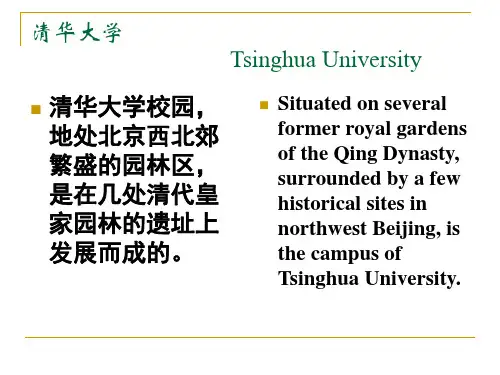
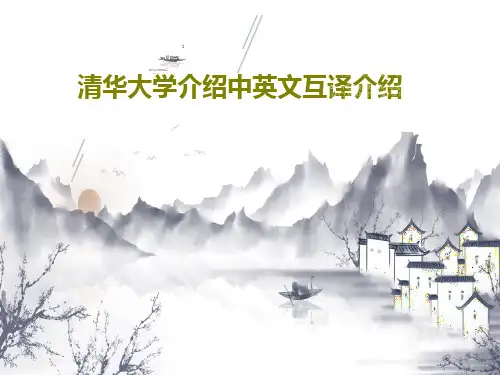
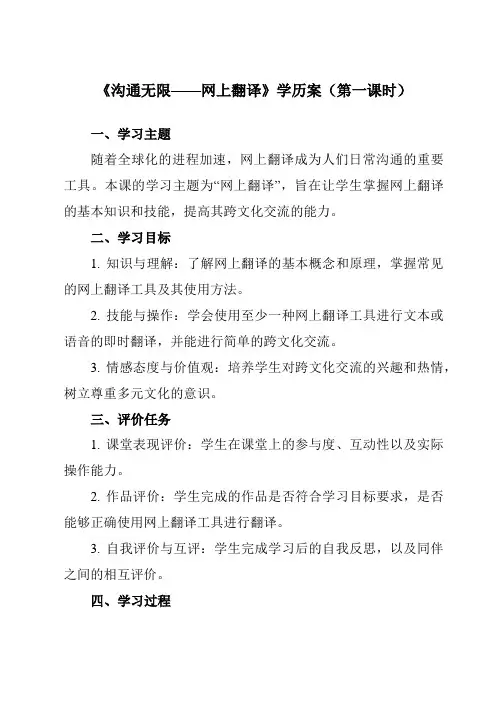
《沟通无限——网上翻译》学历案(第一课时)一、学习主题随着全球化的进程加速,网上翻译成为人们日常沟通的重要工具。
本课的学习主题为“网上翻译”,旨在让学生掌握网上翻译的基本知识和技能,提高其跨文化交流的能力。
二、学习目标1. 知识与理解:了解网上翻译的基本概念和原理,掌握常见的网上翻译工具及其使用方法。
2. 技能与操作:学会使用至少一种网上翻译工具进行文本或语音的即时翻译,并能进行简单的跨文化交流。
3. 情感态度与价值观:培养学生对跨文化交流的兴趣和热情,树立尊重多元文化的意识。
三、评价任务1. 课堂表现评价:学生在课堂上的参与度、互动性以及实际操作能力。
2. 作品评价:学生完成的作品是否符合学习目标要求,是否能够正确使用网上翻译工具进行翻译。
3. 自我评价与互评:学生完成学习后的自我反思,以及同伴之间的相互评价。
四、学习过程1. 导入新课:通过展示实际生活中的翻译应用场景,激发学生的学习兴趣和好奇心。
2. 理论学习:讲解网上翻译的基本概念和原理,介绍常见的网上翻译工具及其特点。
3. 实践操作:学生实际操作网上翻译工具,如百度翻译、有道翻译等,进行简单的文本或语音翻译。
4. 交流讨论:学生分享自己的使用体验,讨论翻译中可能遇到的问题及解决方法。
5. 小组合作:学生分组进行跨文化交流活动,如模拟与外国友人进行简单对话,锻炼学生的跨文化交际能力。
6. 总结反馈:教师总结本课学习内容,学生提出自己的疑问和建议,以便后续改进。
五、检测与作业1. 课堂检测:学生进行即时翻译练习,检验所学知识的掌握情况。
2. 作业布置:学生选择一种网上翻译工具进行深入研究,了解其功能特点及使用技巧,并完成一篇关于该工具的使用心得报告。
六、学后反思1. 学生反思:学生在完成学习后,应进行自我反思,总结所学知识及技能,以及自己在学过程中的不足和需要改进的地方。
2. 教师反思:教师应对本课的教学过程进行反思,总结教学中的优点和不足,以便在后续教学中进行改进。

清华世文班双语介绍
清华世文班是清华大学附属中学的特色班级之一,主要面向优秀的国内外中学生招生。
该班采用全英文授课,旨在为学生提供更广阔的国际视野和语言环境。
同时,该班注重培养学生的综合素质和创新能力,开设了多门前沿课程和研究性学习项目,如科学研究、英文演讲、国际竞赛等,让学生在不同领域进行深度探究和实践。
此外,该班还为学生提供丰富的文化活动和交流机会,帮助学生更好地融入国际化的学习和生活环境。
目前,该班已经培养了众多优秀的学子,其中包括清华大学、斯坦福大学、哈佛大学等世界著名高校的优秀毕业生。
- 1 -。
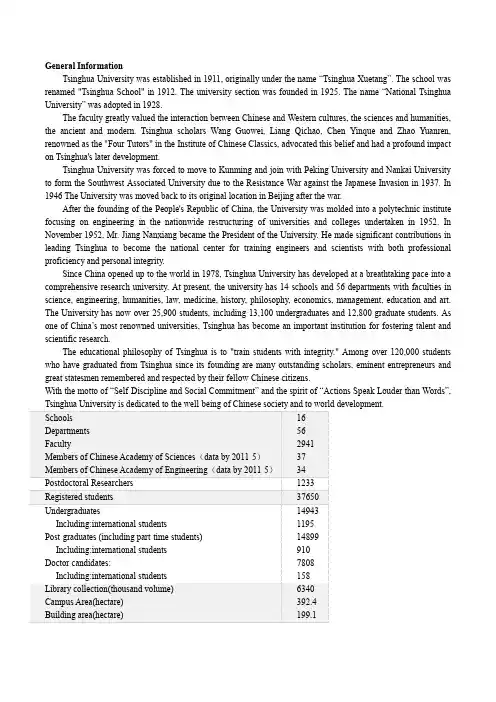
General InformationTsinghua University was established in 1911, originally under the name “Tsinghua Xuetang”. The school was renamed "Tsinghua School" in 1912. The university section was founded in 1925. The name “National Tsinghua University” was adopted in 1928.The faculty greatly valued the interaction between Chinese and Western cultures, the sciences and humanities, the ancient and modern. Tsinghua scholars Wang Guowei, Liang Qichao, Chen Yinque and Zhao Yuanren, renowned as the "Four Tutors" in the Institute of Chinese Classics, advocated this belief and had a profound impact on Tsinghua's later development.Tsinghua University was forced to move to Kunming and join with Peking University and Nankai University to form the Southwest Associated University due to the Resistance War against the Japanese Invasion in 1937. In 1946 The University was moved back to its original location in Beijing after the war.After the founding of the People's Republic of China, the University was molded into a polytechnic institute focusing on engineering in the nationwide restructuring of universities and colleges undertaken in 1952. In November 1952, Mr. Jiang Nanxiang became the President of the University. He made significant contributions in leading Tsinghua to become the national center for training engineers and scientists with both professional proficiency and personal integrity.Since China opened up to the world in 1978, Tsinghua University has developed at a breathtaking pace into a comprehensive research university. At present, the university has 14 schools and 56 departments with faculties in science, engineering, humanities, law, medicine, history, philosophy, economics, management, education and art. The University has now over 25,900 students, including 13,100 undergraduates and 12,800 graduate students. As one of China’s most renowned universities, Tsinghua has become an important institution for fostering talent and scientific research.The educational philosophy of Tsinghua is to "train students with integrity." Among over 120,000 students who have graduated from Tsinghua since its founding are many outstanding scholars, eminent entrepreneurs and great statesmen remembered and respected by their fellow Chinese citizens.With the motto of “Self-Discipline and Social Commitment” and the spirit of “Actions Speak Louder than Words”,History of TsinghuaLocated in the northwestern suburbs of Beijing, Tsinghua University wasestablished in 1911 on the site of “Qing Hua Yuan (Tsinghua Garden)” —a formerroyal garden of the Qing Dynasty. Partly funded by the “Gengzi Indemnity”, alsoknown as “Boxer Indemnity,” it functioned at first as a preparatory school called“Tsinghua Xuetang (Tsing Hua Imperial College)” for those students who weresent by the government to study in the United States.On April 29, 1911, Tsinghua Xuetang began its first term of study, and from thatyear on, the Tsinghua’s anniversary has fallen on the last Sunday of April. Thename was changed to “Tsinghua Xuexiao (Tsing Hua College)” after the 1911Revolution.In 1925, Tsinghua launched its four-year undergraduate programme. In 1928,its name was changed to “Guoli Tsinghua Daxue (National Tsinghua University),”and in the autumn of 1929 its graduate school was set up.Following the outbreak of the War of Resistance against Japan in 1937, Tsinghua University, Peking University and Nankai University merged to form the National Southwest Associated University in Kunming. After the war, Tsinghua University moved back to its original Beijing campus.Three years after the founding of the People’s Republic of China, a nationwide restructuring of institutes of higher education began, and in 1952, Tsinghua University became a multidisciplinary polytechnic university specializing in training engineers. In November of that year, the Ministry of Education appointed Jiang Nanxiang as President.Since 1978, Tsinghua University has strengthened its teaching in sciences, economic management, humanities and law. In 1999, Tsinghua opened the School of Arts and Design by merging with the Central Academy of Arts and Design. Today, Tsinghua has become a leading university: while its teaching is focused on engineering, it concurrently offers degrees in other sciences, the liberal arts, management and law.To fully implement the “China Education Reform and Development Program,” Tsinghua University has set new development targets for the next 15 years. Educational quality and effectiveness will be improved and disciplinary structure will be readjusted. Building on our strength in engineering, the university will promote the development of science and management departments. High academic standards will also be pursued in the humanities and social sciences.In less than 100 years, Tsinghua University has witnessed and shared the hardships and glories of the nation. The University’s motto of “Self-discipline and Social Commitment” has inspired many generations of Tsinghua teachers and students to struggle for the prosperity of China. Now, striving to build Tsinghua University into a world-class university by its 100th anniversary in 2011 has become the objective of each member of the teaching staff and the student body.Tsinghua Garden(清华园-工字厅)Tsinghua Garden is architecturally unique. It preserves original architectural features over three centuries old. The garden retains a traditional Qing private garden design and style with painted corridors connecting every room. It has functioned as the university's head office for many years. Due to its distinctive characteristics, it has become a major attraction on campus.The more popular name of the garden is Gong Zi Ting -- which in Chinese means H-Shaped House. Viewed from above, the central part of the house resembles the letter "H", with its two halls in the front and back connected by a short corridor in the middle.The garden started out as the residence of a Qing emperor’s brother’s family. In the early days of Tsinghua School, founded in 1911, the garden was used as the school’s first head office building. Student enrollment lists were posted on the wall at the front gate. For some years in its history, the east room in the front section was used as the Music Center, the west room as the teacher’s reading room and the back section to accommodate distinguished foreign guests. The great Indian poet Rabindranath Tagore stayed there when he visited China in 1924.Auditorium(大礼堂)Located at the heart of the oldest area on Tsinghua campus is the imposing auditorium. Mixing Greek and Roman architectural styles, the 1,200-seat auditorium has a rounded roof, a brass gate, and four large white marble columns. It possesses few design embellishments; its magnificence is evident in its simplicity.Construction on what is now one of the favorite buildings on campus began in September 1917 and concluded in March 1920. The auditorium was one of the four major building projects carried out by Tsinghua School, together with Tsinghua Xuetang, the old library, and the gymnasium.In its day, it was the largest auditorium of its kind at a university in China, and could seat the entire faculty, staff and student body for school assemblies.Tsinghua School(清华学堂)Tsinghua School, a two floor German style building, was one of the main buildings of the school at it’s early stage. It was a student dormitory building.The west wing was built during 1909-1911. The east wing was built in 1916. The total construction area was 4650 m².The four Chinese characters painted above the main entrance read “Tsinghua School”, the first name of the institution when it was founded. The inscription was by Na Tong, a Great Scholar and Grand Minister in late Qing Dynasty.In the last few decades, it was used as teaching building and classrooms. Now it is the offices of some main administration departments: the Graduate School, the undergraduate academic department and the R&D department.The Old Gate(二校门)The Old Gate was built in 1909. In May of that year, the Qing dynasty government approved the application from the Department of Foreign Affairs to establish a school in the suburbs of Beijing. Tsinghua Garden was chosen as the site for the school. The Gate was the main entrance to the school campus at that time.At that time, the Gate was not only stately and graceful, but also heavily guarded. In those years, underclassmen were not allowed to go beyond the gate without permission from school authorities. In addition, for the sake of preserving the sanctity of the learning environment, people not on official school business were forbidden to pass through the gate.In 1933, after the expansion of the residential area, the former enclosing wall was moved to further out. A new gate, now Tsinghua's West Gate, became the new main entrance. Ever since, the original gate has been called Er Xiao Men (means "the second school gate").The Old Gate was demolished in 1960’s. Donated by Tsinghua University Alumni, it was rebuilt in 1991, following the original design.Shui Mu Tsinghua(水木清华)Shui Mu Tsinghua, which means "clear water and trees surrounding Tsinghua," is one of the most captivating spots in Tsinghua Yuan. Located near the rear gate of the H-shaped Hall, Shui Mu Tsinghua is often compared by Tsinghua students to the Garden of Harmonious Interests in Beijing's famed Summer Palace. It is a "garden within a garden."Shui Mu Tsinghua has many charms. Unusual rock formations abound, and a variety of trees, which change color from season to season, encircle an expanse of calm, clear water. On the northern bank are two ancient, graceful pavilions. The four Chinese characters "Shui Mu Tsing Hua" painted on the top of the main gate, were copied from an inscription by Emperor Kang Xi.The Main Building(主楼)The Main Building, located in the eastern area of campus, is composed of three sections covering a total area of 76,871 square meters. It was jointly designed by the Tsinghua students and teachers from different departments after the liberation of China.For more than 30 years since it was set up, the Main Building held many departments, including those of Architecture, Automation, Computer Science, Mathematics, and Foreign Languages, making significant contributions to both teaching and scientific research.Today, the central and east sections are the home of the departments of Automation, Computer Science and Technology, and Electronic Engineering. The west section mainly houses the department of Electrical Engineering and Applied Electrical Technology.School of Science(科学馆)The building that houses the School of Science was built and put into use just before Tsinghua's 50th anniversary in 1961. It was designed in the Western Classical style by professors from the School of Architecture and Guan Zhaoye, a member of the Chinese Academy of Engineering.The School of Science has a long and brilliant history. It was established in 1929. The first president was renowned physicist Ye Qisun, one of the founders of modern science education in China. Since it opened, it has produced a number of outstanding scholars. By the end of 1940, the department of Physics alone had produced many academicians for the Chinese Academy of Science, including Wang Jinchang, Zhou Tongqing, Gong Zutong, Zhao Jiuzhang, Fu Chengyi, Wang Zhuxi, Weng Wenbo, Zhang Zongsui, Qian Weichang, Peng Huanwu, Qian Sanqiang, He Zehui, Wang Daheng, Yu Zhongzheng, Ge Tingsui, Qin Xinling, Lin Jiaqiao, Zhang Enqiu, Hu Ning, Chen Fangyun, Li Zhengwu, and Lu Xueshan.Graduating from other departments were noted scholars Xu Baolu, Ke Zhao, Duan Xuefu, Chen Xingshen, Yuan Hanqing, Hua Luogeng, Zhang Dayi, Wang Dexi, Cao Benxi, Zhang Qinglian, Feng Xinde, Chen Xinmin, Huang Peiyun, Sun Dehe, Zhu Yajie, Shen Panwen, Tang Aoqing, Yan Dongsheng, Xiao Lun, Shi Jun, Chen Guanrong, Wu Chi, Gao Zhenheng, Wang Shizhen, Wang Fuxiong, Wu Zhengyi, Wang Zhijun, Lou Chenghou,Xu Ren, Huang Shaoxian, Cheng Chunshu, Xie Yibing, Wang Hongzhen, Cheng Yuqi, Dong Shenbao, Wu Heng, Zhang Bingxi, Ye Duzheng, Guan Shicong, Yang Zunyi, Song Shuhe.Palace of the Ancient Moon(古月堂)Near the H-Shaped Hall, the Palace of the Ancient Moon stands alone as a secluded courtyard. Being 670 square meters large, it was constructed in the second year of Emperor Dao Guang's reign. Originally it was the private study chamber of the host. When the school was founded, it became a living quarters for the school staff, and noted scholars such as Prof. Liang Qichao and Prof. Zhu Ziqing also lived there. In 1928, it was designated as a dormitory for the school's first group of female students. Since the founding of the People's Republic of China, ithas housed the school's administrative offices.Gymnasium(西操)The gymnasium, distinguished for its historic and cultural value, has been one of the most beloved spots on campus for generations of Tsinghua graduates. It has been a gathering place for the most outstanding people in the field of physical education, bringing up thousands of talented athletes to represent China. Pioneers of physical education such as John Ma and Hao Gengshen taught there for decades.The gym was constructed in two stages. The front hall, with its Western Classic architectural style, was built from 1916 to1919. The back hall was built from 1931 to 1932, and followed the same design style.When it was founded, the gym was one of the most advanced of its kind in the country. It housed a basketball court, an suspension athletic track, and various kinds of athletic equipment. It now has an indoor swimming pool, which was used by former Chairman Mao Zedong after the liberation of China.DiningInternational students can apply for a Dining Card at the Food Service Center (Business hours: 8:00-13:00, 15:00-18:00) located in No.15 Building with their Admission Notice/Student ID Cards or certificates issued by FSAO. Students may have meals in any students’ dining hall with this card. A temporary card or cash is required at other dining places. Students are expected to maintain the order of the dining halls, help to keep the places clean and tidy, take care of the facilities and equipment, and show respect to the working staff.Campus ServicesService facilities inside Tsinghua University make the life of students very convenient. The on-campus shopping center is located at Zhaolanyuan, where one can find banks, post office, super-market, bookstores, fruit and vegetable market, photo studios, restaurants, the barber’s, laundries, etc. All kinds of services are also provided in the living area of students.Banking ServiceThe Industrial and Commercial Bank of China, China Construction Bank and Bank of Beijing in Zhaolanyuan shopping center, Bank of China in Zijing Student Service Center (Building C) provide service for deposit and exchange of foreign currencies. US dollar, Euro, Pound, Yen can be exchanged to Renminbi. But the traveler's check is not acceptable there. Large amount of foreign currencies and traveler's check can be exchanged to Renminbi at a branch of Bank of China located at Chuangxin Plaza nearby University's East Gate. Banks open from 9:00 to 17:00 everyday.On-campus Automated Teller Machines (ATMs) can be found at places like the Zijingyuan Dinning Hall, the Taoliyuan Dinning Hall, the Zijing Building No.4, 5 and 6, the post office, the Industrial and Commercial Bank of China, outside the Tingtaoyuan (formerly named No.10 Dining Hall), on the first floor of Guanchouyuan(formerly named Dining Plaza), the Financial Department of the University, etc.Mailing ServiceThe post office located in the Student Service Center located in the west of the Zijing dormitory and Zhaolanyuan opens from 8:30 to 17:30 everyday, providing services of mailing, sending and receiving parcels, fax, telegram, distance calls, etc.ShoppingThe shopping center of Tsinghua is located in Zhaolanyuan. Besides, several other supermarkets can be found, such as the Zijing Student Supermarket at the underground floor of the Student Service Center, Zijing Supermarketin the Dining Plaza, and the Student Supermarket between No.7 and No.8 student dormitories. Banks, shops and bookstores are installed at the Student Service Center.Sports FacilitiesThe on-campus sports facilities include the following.The indoor swimming and diving gymnasium, and the West Lake outdoor swimming pool (Open from June.1st to Sep 1st each year).The comprehensive gymnasium (sports facilities provided: badminton, table tennis, basketball, and gymnastic apparatus).Western gymnasium (sports facilities provided: badminton, basketball, and billiards).The plastic tennis court, the eastern gymnasium, and the table tennis Center.International students may use the above mentioned services with Student ID cards and pay relevant fees.Library Collections●General IntroductionTsinghua University Library's collection is emphasized on Science and Technology and also covers broad subjects of Humanities, Social Sciences and Management. The total collection amounts to more than 3.96 million items, including:Printed Collections•222,282 thread-bound ancient books;•More than 3,268 current serials and 585,976 bound periodicals;•More than 94,836 Tsinghua University dissertations and theses;•More than 20,000 microforms;•Other books.Electronic Resources•Near 57,000 full-text e-journals;•459electronic databases;•More than 2,383,000 e-books;•More than 45,000 multimedia collections.Tsinghua University Library was established in 1912, just one year after the “Tsinghua Xue Tang” was founded. Up to now, Tsinghua university library system includes the university library, 6 subject branch libraries and more than 10 school or department reading rooms. In the past few years the library has expanded its collection very fast especially in the e-resources. The total physical collections have been over4.0 million item/volumes, full-text e-journals in Chinese and foreign languages are over 57,000 and e-books are more than 2.39 million by end of 2010. In 1996, the Library introduced integrated library management system (INNOPAC) for cataloging and circulation management, which was the first one in China. In 2005, the library brought in MetaLib+SFX, the e-resources integration system, established Tsinghua Academic Information Resource Portal. Now the faculty and students of Tsinghua University are able to access the library's e-resources conveniently and safely at any time and from any places.AlumniTsinghua alumni have stepped all over the world and are active in the developed countries such as the United States and Japan, the developing ones including India and Thailand, and the distant southern Africa and South America as well. Around 20,000 alumni currently stay abroad, mostly in North America, and nearly half of them live and work in Silicon Valley under the background of the University’s strength in science and engineering. Nearly 50 Tsinghua alumni organizations have been established in over 10 countries.。
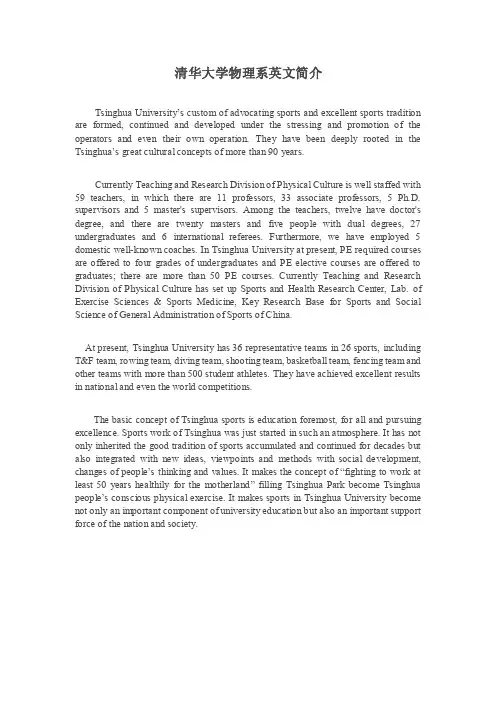
清华大学物理系英文简介Tsinghua University’s custom of advocating sports and excellent sports tradition are formed, continued and developed under the stressing and promotion of the operators and even their own operation. They have been deeply rooted in the Tsinghua’s great cultural concepts of more than 90 years.Currently Teaching and Research Division of Physical Culture is well staffed with 59 teachers, in which there are 11 professors, 33 associate professors, 5 Ph.D. supervisors and 5 master's supervisors. Among the teachers, twelve have doctor's degree, and there are twenty masters and five people with dual degrees, 27 undergraduates and 6 international referees. Furthermore, we have employed 5 domestic well-known coaches. In Tsinghua University at present, PE required courses are offered to four grades of undergraduates and PE elective courses are offered to graduates; there are more than 50 PE courses. Currently Teaching and Research Division of Physical Culture has set up Sports and Health Research Center, Lab. of Exercise Sciences & Sports Medicine, Key Research Base for Sports and Social Science of General Administration of Sports of China.At present, Tsinghua University has 36 representative teams in 26 sports, including T&F team, rowing team, diving team, shooting team, basketball team, fencing team and other teams with more than 500 student athletes. They have achieved excellent results in national and even the world competitions.The basic concept of Tsinghua sports is education foremost, for all and pursuing excellence. Sports work of Tsinghua was just started in such an atmosphere. It has not only inherited the good tradition of sports accumulated and continued for decades but also integrated with new ideas, viewpoints and methods with social development, changes of people’s thinking and values. It makes the concept of “fighting to work at least 50 years healthily for the motherland” filling Tsinghua Park become Tsinghua people’s conscious physical exercise. It makes sports in Tsinghua University become not only an important component of university education but also an important support force of the nation and society.HistoryTsinghua Sport has a long history with a solid foundation. As the window of promoting sports, improving and strengthen the health of students, Division of Physical Education has been involved in the century torrent of Tsinghua University.In 1912, as with the promotion of the physical education conception“Ethic, Intelligence, Physical quality”brought by President Zh ou Yichun, the Division of Physical Education was formally founded. “The reason why a country is weak due to its weak people, which is the result of impopularization of physical education”. Since the Division of Physical Education was founded, it has advocated that the purpose for doing sports is to make the nation stronger. Therefore, high quality teaching resource is the precious wealth for the realization of setting goals and guarantee for the development of the division. Celebrities such as Shoemaker, Brace, John Mo, Li Jianqiu, Xia Xiang, etc.have lent strong foundation for the basis of Division.Establishing reasonable course systems and doing appropriate sports is the key to improving students’ health and body quality. With the gradual development of Division of Physical Education at Tsinghua University, Division gradually put forward some measures such as“Coercive Physical Education”,“Five Item Tests”, “Setting Physical Education Classes”,etc. in order to set up comprehensive requirements for students. Especially during the Era of National Southwest Associated University, the smoke of War did not prevent Division from developing and improving Physical Education, Brand new events as“Bull Fight”, “Flag Getting” brought about a piece of spiritual sustenance for students who had been suffering the war.“Screaming once, watching Tsinghua with sword”, after the war, “healthy” had been the goal people were chasing for. In the year 1957, President Jiang Nanxiang put forward that “Working for our motherland healthily for at least 50 years”, this quote had not only become the goal for Tsinghua students, but also the explanation of cultivating students with the thought of “Improving on the basis of popularization,popularizing under the conduct of improvement”. T herefore, on the command of teachers as John Mo, Xia Xiang, Wang Yingjie, Wang Weiping, Yang Daochong, etc., actively promoting “Working & Defending the Nation System”and “Five Excercises Standards” and at the same time organized 38 representative team whi ch had as many as 450 people, with the biggest scale and largest number of events among all the universities at that time according to the requirement of “Amateur catches the professional”, which had largely prospered the sports activities on and off campu s as well as promoted the popularization of sports activities among the students.Since the start of Reform and Opening up Policy, the tradition of Tsinghua University had been further carried forward, the majority of students had gradually formed the habit of keeping exercising. Sports was given the connotation of new era. At this moment, Division of Pysical Education kept the sense of education of “Educating people first when emphasizing on both body and morality” and advocated the combination of education and sports, brought the sports into the track of the development of school subjects, which hence went into a new era of development.The basic theory of Tsinghua Sports is “Educating first, facing all the people, in pursuit of excellence”. However, culti vating real talents for the nation must maintain the policy of comprehensive development of “Ethic, Intelligence, physical, beauty, labor” should focus on the comprehensive building and Honing for the youth’s healthy personality. Thus, Division actively carried on sport activities for people, emphasized on the overall development of students, Sports events as “John Mo Cup” Students Track and Field Sports Meeting, Freshman Sports Meeting and Beijing International Marathon Competitions composed the system of competitions for people all the year round. Besides, in order to implement national policies of “National Fitness Program” and ”Olympics Glory Plan”, Division of Physical Education tried to establish high level student ethlete team in October, 1999, on the basis of combining detailed national situation and widely referring to the experience of success of those sports developed countries, which began a mean of nation training student athletes and contributed for the popularization of athletic sports among Chinese university students. So far, there are 36 representative teams of 26 sports events, including Trackand Field Team, Rowing Team, Diving Team, Shooting Team, Basketball Team, Fencing Team, Football Team, Volleyball Team, Swimming Team, Table Tennis Team, etc., there are more than 500 student athletes, who have made excellent results among national and International competitions. During 2008 Beijing Olympics, Hu Kai cooperated with teammates in 4*100 Relay Race and ranked 4th Place in the group in first round, they successfully went into the final game with the result of 39’’13, which created a new history in Chinese Track and Field event.Since the mid-90s, with the standardization of physical education, Scientificization of sports management, systemization of group activities, internationalization and popularization of athletic sports, the position of the function of modern college sports is changing. Therefore, Division of PE at Tsinghua make "Entering the mainstream, Uniqueness, High starting point, Openness" as the guidelines, put PE into the academic track of construction. In the first term of "985" project, 500 million RMB were invested for Physical Education building, it also established "Sports and Health Science Research Center of Tsinghua University" in 1996 and applied one point of Master’s Degree of "Physical Education and Training Degree” and two points of Master’s Degree of the "Human Kinesiology" and "Sport humanities and sociology" and one point of Master's Degree" Physical Education and Training". In 2009, a new post-doctoral research station was newly added. Up to now, there are 59 teachers in total in the Division of Physical Education, among which, there are 9 professors, 33 associate professor and 4 Doctoral tutors, 8 Master tutors. Amo ng teachers, there are 11 people with Doctor’s Degree, 16 with Master's Degree, 5 with dual degrees, 24 Undergraduate students, 3 International referees. The division has also trained 23 graduate students and 6 Postgraduate students as well as 6 senior visiting scholars; Completing 58 national and ministries issues and published 423 papers in total. During the 2008 Beijing Olympic Games, part of the faculty in the Division of Physical Education was in charge of referee works on the courts. Mr. Chen Weiqiang was the Chief Referee in the Track and Field competitions during the Olympics.PE class is the core of curriculums in colleges and physical works, which is the basic form of physical education. Considering the educational demand of Tsinghua University, department of physical education makes out the instructional plan of physical education in Tsinghua University. Nowadays, it orders that the physical educational model of undergraduate students is "4+2+2", and there are optional courses provided for graduate students.In conclusion, any kind of sincere pursuit is originated from original motivation and pure life, which is presented by denying an old-self and reestablishing a new one. There is no exception in our sports department. At the Century anniversary o f the founding of Tsinghua University, when we recall our fadeless memory, we merely intend to edge six aspects of our sports---physical education, mass sports activities, competition sports, sports scientific research, construction of teaching faculty, as well as venues and facilities into top class among domestic common universities (domestic non-PE-major universities) through our effort. We will carry forward fine traditions and keep pace with the times in an enterprising, innovative, scientific and pragmatic spirit as to push forward the overall development of sports in our university. We intend to make sports not only an important component of our university’s education, but also a major support for national and social sports.。
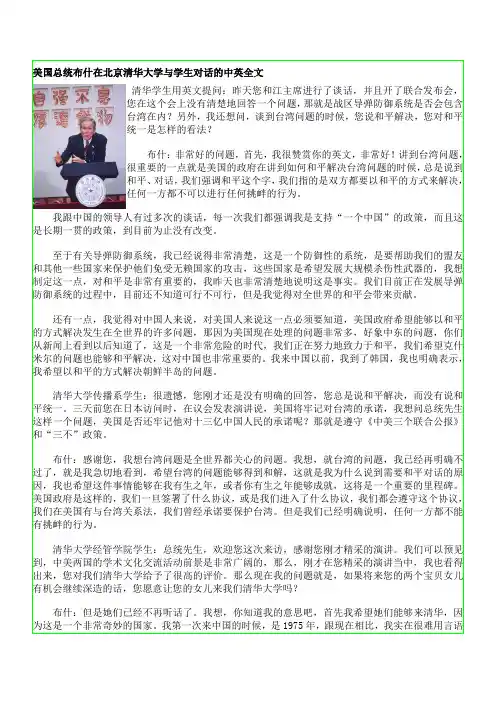
美国总统布什在北京清华大学与学生对话的中英全文清华学生用英文提问:昨天您和江主席进行了谈话,并且开了联合发布会,您在这个会上没有清楚地回答一个问题,那就是战区导弹防御系统是否会包含台湾在内?另外,我还想问,谈到台湾问题的时候,您说和平解决,您对和平统一是怎样的看法?布什:非常好的问题,首先,我很赞赏你的英文,非常好!讲到台湾问题,很重要的一点就是美国的政府在讲到如何和平解决台湾问题的时候,总是说到和平、对话,我们强调和平这个字,我们指的是双方都要以和平的方式来解决,任何一方都不可以进行任何挑衅的行为。
我跟中国的领导人有过多次的谈话,每一次我们都强调我是支持“一个中国”的政策,而且这是长期一贯的政策,到目前为止没有改变。
至于有关导弹防御系统,我已经说得非常清楚,这是一个防御性的系统,是要帮助我们的盟友和其他一些国家来保护他们免受无赖国家的攻击,这些国家是希望发展大规模杀伤性武器的,我想制定这一点,对和平是非常有重要的,我昨天也非常清楚地说明这是事实。
我们目前正在发展导弹防御系统的过程中,目前还不知道可行不可行,但是我觉得对全世界的和平会带来贡献。
还有一点,我觉得对中国人来说,对美国人来说这一点必须要知道,美国政府希望能够以和平的方式解决发生在全世界的许多问题,那因为美国现在处理的问题非常多,好象中东的问题,你们从新闻上看到以后知道了,这是一个非常危险的时代,我们正在努力地致力于和平,我们希望克什米尔的问题也能够和平解决,这对中国也非常重要的。
我来中国以前,我到了韩国,我也明确表示,我希望以和平的方式解决朝鲜半岛的问题。
清华大学传播系学生:很遗憾,您刚才还是没有明确的回答,您总是说和平解决,而没有说和平统一。
三天前您在日本访问时,在议会发表演讲说,美国将牢记对台湾的承诺,我想问总统先生这样一个问题,美国是否还牢记他对十三亿中国人民的承诺呢?那就是遵守《中美三个联合公报》和“三不”政策。
布什:感谢您,我想台湾问题是全世界都关心的问题。
清华大学:追求卓越,培育未来领袖Nestled in the heart of Beijing, Tsinghua University stands as a beacon of academic excellence and innovation. Founded in 1911, this prestigious institution has a rich history that spans over a century, yet it remains at the forefront of educational reform and research. With a focus on science and engineering, Tsinghua University has grown to become one of the most respected universities in the world, attracting students and scholars from all corners of the globe.The campus of Tsinghua University is a vibrant hub of intellectual activity. Its beautiful grounds, filled with lush greenery and serene lakes, provide a serene environment for study and reflection. The academic buildings, equipped with state-of-the-art facilities, are home to world-class research centers and laboratories where groundbreaking research is conducted.The faculty at Tsinghua University is highly regarded for their expertise and dedication to teaching. They are committed to providing students with a rigorous and comprehensive education that prepares them for thechallenges of the future. The courses offered at Tsinghua are diverse and extensive, covering a range of disciplines including engineering, science, humanities, and social sciences.The student body at Tsinghua University is equally impressive. They come from diverse backgrounds and possess a strong sense of purpose and ambition. The university fosters a culture of innovation and collaboration, encouraging students to push the boundaries of their knowledge and to contribute to society.One of the unique features of Tsinghua University isits commitment to internationalization. The university has established partnerships with numerous institutions around the world, facilitating exchange programs andcollaborations that broaden the horizons of its students and faculty. This international perspective is integral to the university's mission of preparing global leaders who can navigate the interconnected world.Tsinghua University's alumni are a testament to its excellence. They have gone on to achieve remarkable success in various fields, including science, technology, business,and politics. Their achievements reflect the impact of the university's rigorous education and its commitment to fostering leaders who make a positive difference in the world.In conclusion, Tsinghua University stands as a beacon of excellence in higher education. Its commitment to academic research, innovation, and internationalization has made it a leader in global education. As it continues to shape the future of education and leadership, Tsinghua University remains a beacon of hope and aspiration for students and scholars from around the world.**清华大学:追求卓越,培育未来领袖**清华大学位于中国的心脏地带——北京,是学术卓越与创新的灯塔。
Academic organisation of Tsinghua UniversityThe Tsinghua BellSchool of Architecture∙Department of Architecture∙Department of Urban Planning and Design∙Department of Building Science∙Department of Landscape ArchitectureSchool of Civil Engineering∙Department of Civil Engineering∙Department of Hydraulic Engineering∙Department of Construction ManagementSchool of Mechanical Engineering∙Department of Mechanical Engineering∙Department of Precision Instruments and Mechanology ∙Department of Thermal Engineering∙Department of Automotive Engineering∙Department of Industrial EngineeringSchool of Aerospace∙Department of Engineering Mechanics∙Department of Aeronautics & Astronautics Engineering School of Information Science and Technology∙Department of Electronic Engineering∙Department of Computer Science and Technology∙Department of Automation∙Institute of Microelectronics∙Department of Microelectronics and Nanoelectronics∙School of Software∙Department of Environmental Science and Engineering∙Department of Electrical Engineering∙Department of Engineering Physics∙Department of Chemical Engineering∙Department of Materials Science and EngineeringSchool of Sciences∙Department of Mathematics∙Department of Physics∙Department of Chemistry∙School of Life Sciences[15][16]School of Humanities∙Department of Philosophy∙Department of Chinese Language and Literature∙Department of Foreign Languages∙Department of HistorySchool of Social Sciences∙Department of Sociology∙Department of Political Science∙Department of International Relations∙Department of Psychology∙Institute of Economics∙Institute of Science, Technology and SocietSchool of Economics and Management∙Department of Management Science and Engineering∙Department of Economics∙Department of Finance∙Department of Accounting∙Department of Innovation and Entrepreneurship∙Department of Human Resources and Organizational Behavior ∙Department of Business Strategy and Policy∙Department of Marketing∙School of Public Policy & Management∙Tsinghua Law SchoolAcademy of Arts and Design∙Department of Art History∙Department of Industrial Design∙Department of Environmental Art Design∙Department of Ceramic Design∙Department of Visual Communication Design∙Department of Textile and Fashion Design∙Department of Art and Crafts∙Department of Painting∙Department of Sculpture∙Department of Information Art & DesignSchool of Medicine∙Department of Medical Science∙Department of Pharmaceutical Science∙Department of Biomedical Engineering∙School of Journalism and Communication∙Institute of Nuclear And New Energy Technology∙Department of Physical EducationDepartment of Mathematical Sciences[edit]Department of Mathematical Sciences (DMS) was established in 1927. As one of the premier Departments of Mathematical Sciences in China, DMS is famous for its rigorous academic attitude. Many famous Chinese mathematicians from DMS such as Shiing-Shen Chern and Luogeng Hua became well-known to the world.In 1952, Tsinghua DMS was merged with the Peking University Department of Mathematical Sciences. Then in 1979 it was renamed "Department of Applied Mathematics", and renamed again in 1999 to its current title.Tsinghua DMS has three institutes at present, the institute of Elementary Mathematics which has 27 faculty members, the Institute of Applied Mathematics and Probability and Statistics which has 27 faculty members, and the Institute of Computational Mathematics and Operations Research which has 20 faculty members. There are currently about 400 undergraduate students and 200 graduate students.School of Life SciencesSchool of Life Sciences was first established in 1926 under the name Department of Biology. Botanist Qian Chongshu took up the first dean.During the nationwide reorganization of universities in the early 1950s, the Department of Biology was merged into other universities, namely Peking University etc.,resulting in a vacancy in the field of biological research in Tsinghua for almost 30 years.In June 1984, decisions were made about the reestablishment of the Department of Biology, and the department officially reopened in September. During the reestablishment the Department of Biology of Peking University, the Institute of Biophysics of Chinese Academy of Sciences, and many other institutes as well as biologists provided valuable support and help. The department changed its name to the current name in September 2009. As of 2013, structural biologist and foreign associate of National Academy of Sciences of United States[17]Dr. Yigong Shi is the current dean of School of Life Sciences. The school currently has 38 professors, around 600 undergraduates (including the candidates of Tsinghua University - Peking Union Medical College joint MD program) and 200 graduate students.School of Economics and ManagementMain article: Tsinghua University School of Economics and ManagementSchool of Journalism and CommunicationThe Tsinghua School of Journalism and Communication (TSJC) was established in April 2002. Its predecessor was Communication Studies in the Department of Chinese Language and Literature and its establishment of coincides with the development of media increasingly influencing world affairs in a time of fast-growing globalization. The school's research fields include International Communication, Film and Television Studies, New Media Studies, Media Operation and Management, and Business Journalism and are based on comprehensive academic research in journalism and communication theories. The objective of the school is to bring full advantage of Tsinghua University's comprehensive academic structure to Chinese and international media, to construct a first-rate discipline in journalism and communication studies, to cultivate talented professionals in the field and to explore advanced concepts in journalism and communication. The school also offers a two-year graduate program in international business journalism, sponsored by Bloomberg L.P. and the International Center for Journalists (ICFJ), that trains talented students and media professionals from around the globe in financial media and corporate communication.[18]The school has five research-oriented centers to organize and conduct academic research activities. They are: Center for International Communications Studies, Center for New Media Studies, Center for Film and Television Studies, Center for Media Management Studies and Center for Cultural Industry Studies.[18]The first and present dean of the school is Fan Jingyi, a notable chief editor of People's Daily during the period of the 1990s.Graduate School at Shenzhen, Tsinghua UniversityThe Graduate School at Shenzhen, Tsinghua University, was jointly founded by Tsinghua University and the Shenzhen Municipal Government. The school is directly affiliated with Tsinghua University in Beijing. The campus is located in the University Town of Shenzhen since October 18, 2003.[19]。